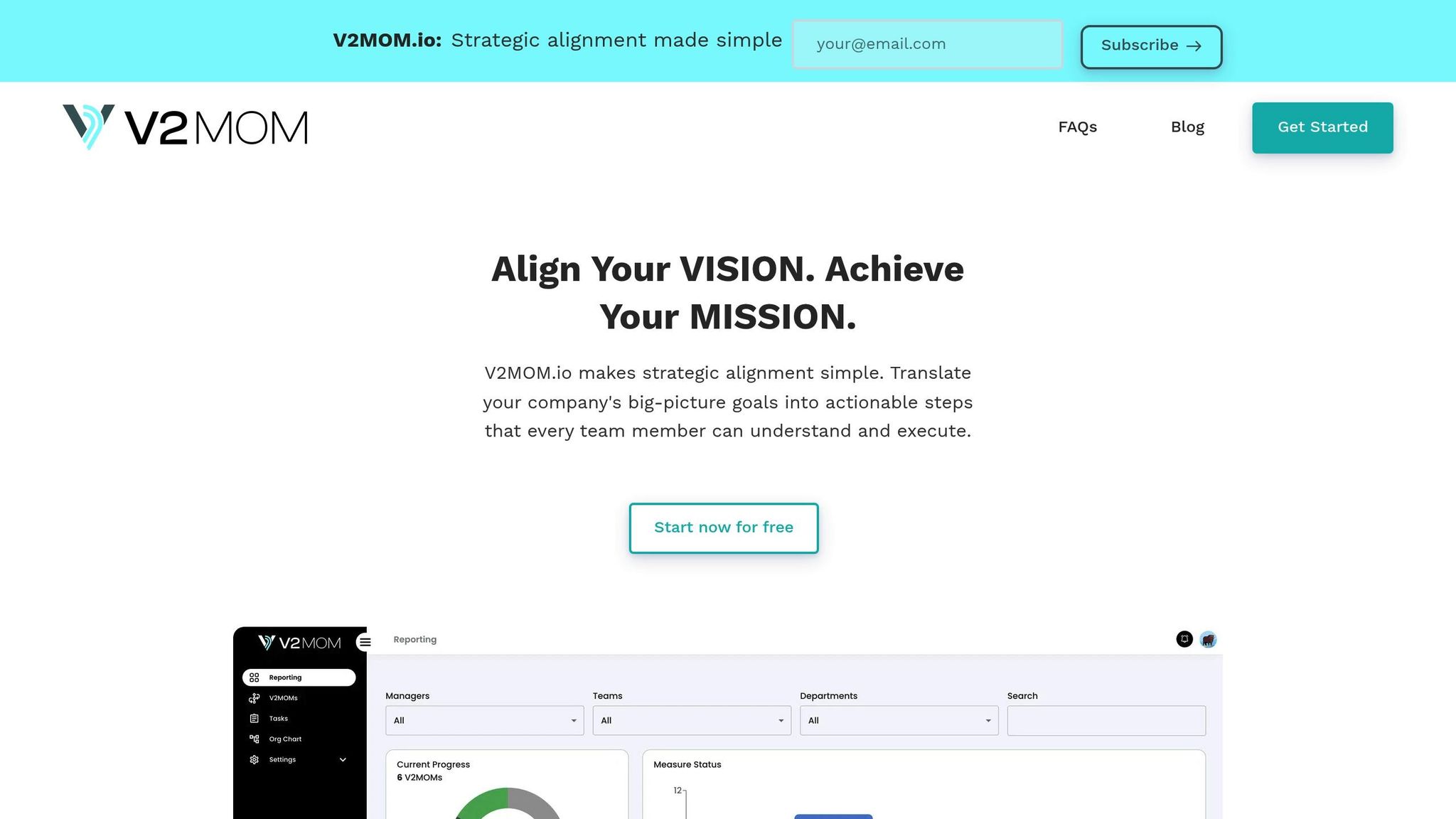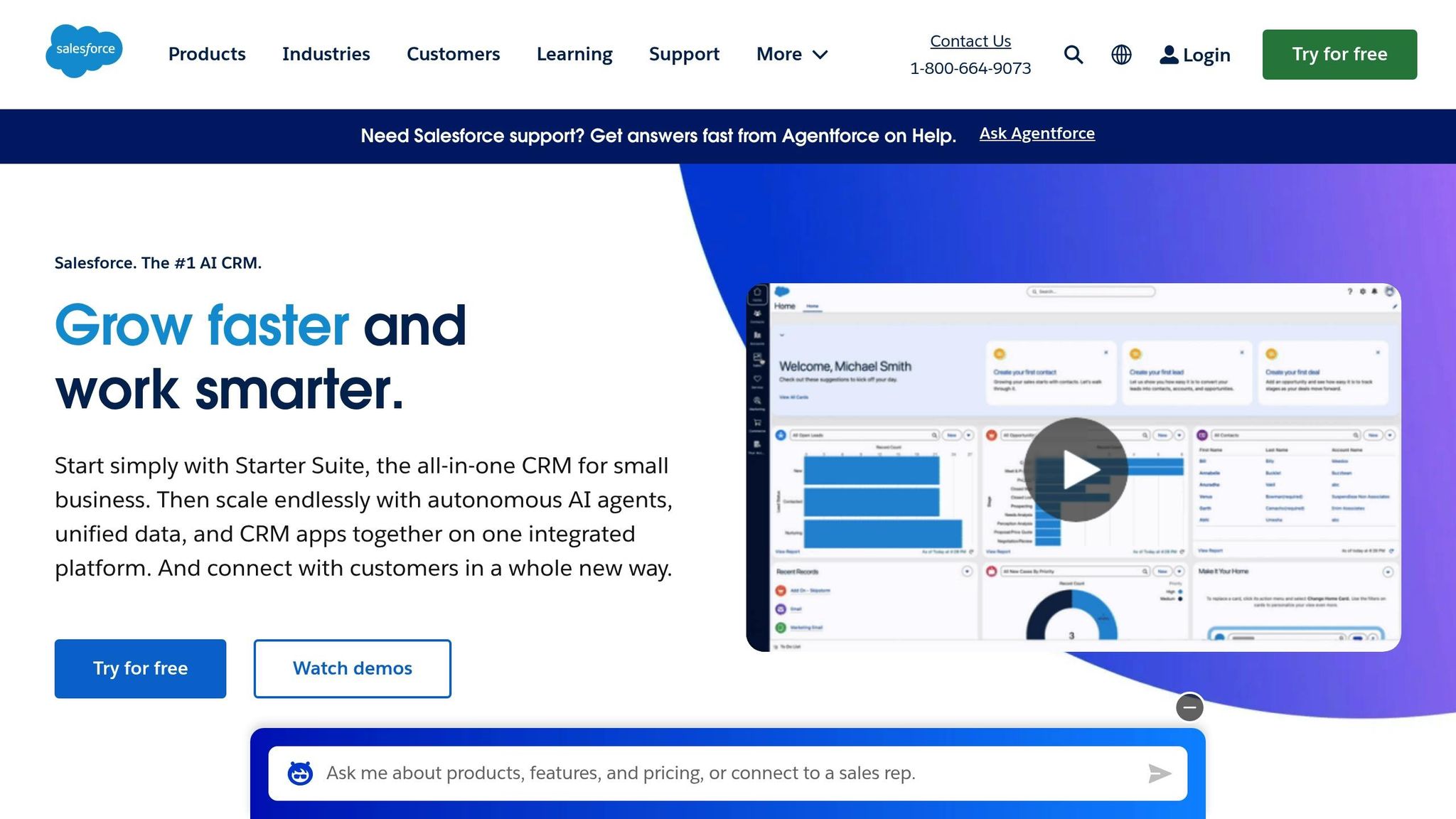Strategic alignment is broken, and it’s costing companies growth. Only 28% of leaders can clearly explain their company’s goals, and misalignment is rising, with 44% of teams reporting workflow challenges in 2024. The result? Wasted resources, poor communication, and missed deadlines. V2MOM.io was created to fix this.
This platform uses the proven V2MOM framework - Vision, Values, Methods, Obstacles, and Measures - to centralize goals, track progress in real-time, and connect teams. Unlike outdated planning methods, V2MOM.io ensures your plans aren’t static but continuously actionable.
Here’s what sets V2MOM.io apart:
- Clarity: Teams know exactly where they’re headed and why.
- Collaboration: Breaks silos and aligns departments.
- Progress Tracking: Real-time dashboards keep projects on course.
- Flexible Plans: Adjust goals without losing focus.
With a free Starter plan for small teams and a Business plan at $5.99/user/month, V2MOM.io is built for organizations of all sizes. Start using it to align your team, improve accountability, and turn plans into results.
Understanding the Problems with Traditional Strategic Planning
Common Pain Points in Traditional Planning
Traditional strategic planning often sets organizations up for failure by creating misalignment and confusion. One of the biggest culprits? Unclear vision and inconsistent communication. When the strategy isn’t clearly communicated, teams end up working at cross-purposes, wasting precious time and resources.
Adding to the chaos are siloed teams. Departments frequently interpret company goals in their own way, leading to conflicting priorities and redundant efforts. This fragmentation becomes even more pronounced when organizations try to coordinate across multiple locations or departments.
The rigidity of traditional planning only makes things worse. Many companies stick to annual planning cycles, which simply can’t keep pace with rapidly changing markets or unexpected disruptions. Charlotte Laing, Head of Marketing at Metrikus and AirRated, puts it perfectly:
"When something comes up that alters your strategy, alter your plan. Don't hang on to sunk costs because it was perfect before: recognize that the equation has changed and move forward." [1]
Then there’s the issue of information overload. Traditional planning often results in lengthy documents filled with analysis - plans that take months to create but are outdated before they’re even implemented.
Another major flaw lies in the reliance on external consultants. While consultants bring expertise, they often lack the deep understanding of an organization’s culture and internal dynamics. This disconnect results in strategies that look good on paper but fall apart in execution.
Accountability gaps are another stumbling block. Without clear ownership of roles and responsibilities, strategic initiatives tend to drift. Harvard Business School Professor Robert Simons highlights the importance of job design in this context:
"Job design is a critical part of strategy execution. If individuals don't have the resources they need and aren't accountable in the right way, they won't be able to work to their potential." [3]
Finally, there’s the challenge of aligning strategy with organizational culture. As David A. Shore, instructor at Harvard DCE, explains:
"People are people - carbon and water. As such, we resist change. It's important to recognize that managing change is about upsetting people only at a rate that they can tolerate." [4]
These issues collectively create a significant gap between the clarity organizations aim for and the reality of traditional planning methods.
What You Want vs. What You Get
The shortcomings of traditional planning become even more evident when you compare the ideal outcomes of strategic execution with the results these outdated methods actually deliver. Here’s how they stack up:
| What You Want | What You Get with Traditional Planning |
|---|---|
| Clear Direction | Overly complex, multi-page documents that create confusion |
| Agile Response | Inflexible annual plans that can’t adapt to change |
| Team Alignment | Fragmented departments pursuing conflicting goals |
| Measurable Progress | Vague objectives with no clear metrics or timelines |
| Employee Engagement | Top-down directives that fail to inspire buy-in |
| Real-time Visibility | Quarterly updates that are outdated by the time they’re shared |
| Collaborative Planning | Consultant-led efforts with limited internal involvement |
| Continuous Improvement | Static plans that remain untouched until the next cycle |
The consequences of these mismatches are hard to ignore. Research shows that companies investing more time and effort into strategy execution are three times more likely to report above-average growth and twice as likely to report above-average profits [3]. Yet many organizations continue to cling to methods that almost guarantee poor execution.
Alon Waks, CMO and Advisor at Flywheel Consulting, highlights a key pitfall:
"A common pitfall is relying on older data that's not adjusted for a new reality. Past intuition is great, but data needs to help lead the discussion and decision. We're all writing a new playbook." [1]
This reliance on outdated data reflects a deeper issue: traditional planning assumes that the future will mirror the past. But in today’s fast-changing business landscape, that assumption no longer holds. In fact, nearly all business leaders surveyed believe their company’s business model will need to change within the next three years [2]. Sticking with outdated methods puts organizations at a disadvantage.
The human impact is just as serious. Over half of business leaders worry that their organizations aren’t adapting quickly enough [2], creating stress and uncertainty that erode confidence. When employees don’t see how their daily work connects to the broader strategy, engagement plummets, and turnover rises.
Traditional planning also fails to deliver the short-term wins needed to maintain momentum. Without visible, measurable progress, teams lose motivation, and leadership risks losing credibility. This creates a vicious cycle where poor execution undermines trust in strategic planning, making success even harder to achieve.
The V2MOM Framework: A Proven Foundation for Success
Overview of the V2MOM Framework
The V2MOM framework simplifies the process of strategic planning by focusing on five essential elements: Vision, Values, Methods, Obstacles, and Measures [5].
Each piece of the framework plays a distinct role. Vision answers the question, "Where do we want to go?" - it’s the ultimate destination [8]. Values clarify, "What’s most important about how we get there?" [8]. Methods outline the steps needed to achieve the vision, answering, "What actions do we need to take?" [8]. Obstacles identify potential challenges, asking, "What stands in our way?" [8]. Finally, Measures define success by asking, "How will we know when we’ve succeeded?" [8].
Marc Benioff, Chairman and CEO of Salesforce, highlights the framework’s simplicity:
"Although there are many leadership paradigms and frameworks available to executives these days, the V2MOM approach champions its simplicity. It is easy to digest and implement." [6]
Despite its straightforward nature, V2MOM offers depth and flexibility. It works across departments, ensuring alignment from top to bottom while allowing teams to tailor the framework to their needs [5]. This balance of consistency and adaptability is one of its greatest strengths.
Benioff further underscores the importance of clarity:
"What is the vision for what I want to achieve? That's the first question that must be asked, because if you aren't crystal clear on where you want to go, good luck trying to get there." [6]
By addressing these core questions, the V2MOM framework lays the groundwork for better organizational alignment and smarter decision-making.
Benefits of the V2MOM Approach
One of the standout benefits of V2MOM is its ability to enhance organizational alignment. Traditional strategic planning often falls short in this area, but Salesforce’s journey from a four-person startup to a global company with over 50,000 employees proves the framework’s scalability and effectiveness [6]. In fact, V2MOM has been central to every major decision at Salesforce since its inception in 1999, starting with the original framework scribbled on an American Express envelope [6].
The results speak for themselves: 95% of Salesforce employees report understanding how their work contributes to the company’s success [9]. This clarity fosters collaboration and accountability by breaking down silos and assigning clear ownership of goals. Supporting this, a Deloitte survey found that teams with defined ownership of goals outperform others by 50% [10].
The framework also strengthens data-driven decision-making. A McKinsey study found that organizations leveraging data are 23 times more likely to attract customers, six times more likely to retain them, and 19 times more likely to achieve profitability [10]. V2MOM supports this approach while encouraging adaptability, creativity, and empowerment [6]. Unlike rigid traditional plans, it provides structure without stifling flexibility, allowing teams to adjust their strategies and tackle obstacles while staying aligned with the overarching vision and values.
Why We Built V2MOM.io: Solving Strategic Alignment Problems

Finding the Gaps in Existing Tools
The idea for V2MOM.io was sparked by a noticeable disconnect between what businesses need and what traditional planning tools offer. While the V2MOM framework had already shown its value at companies like Salesforce, many organizations still struggled to keep up with the demands of today’s fast-paced environment.
Marc Benioff, Chairman and CEO of Salesforce, summed up this issue well:
"Stagnant management tools like once-a-year performance reviews don't cut it in today's fast-moving environment, which requires that companies adapt continuously." [6]
Old-school tools often result in communication breakdowns and departmental silos, especially as teams expand. Instead of empowering all employees, these outdated systems tend to lock strategic plans within the confines of executive discussions.
This gap became the driving force behind creating V2MOM.io, a tool designed to bring agility and clarity to strategic planning.
Core Features of V2MOM.io
V2MOM.io takes the proven V2MOM framework - focusing on vision, values, methods, obstacles, and measures - and turns it into a digital platform. By consolidating these elements in one place, the platform becomes a central hub where teams can define and share their company’s strategic direction seamlessly [11].
At its core, V2MOM.io provides real-time progress tracking. Unlike static documents, the platform uses dynamic dashboards to monitor objectives as they evolve, helping leaders identify challenges early and make smarter, data-driven decisions.
Collaboration is another key feature. The platform connects team members to the company’s broader goals, breaking down silos and ensuring everyone understands how their efforts contribute to the bigger picture. Built-in analytics add another layer of value, offering insights into what’s working and where adjustments may be needed.
V2MOM.io caters to businesses of all sizes - from startups to large enterprises. Its pricing is equally flexible, with a free Starter plan for up to 10 users and 3 teams, and a Business plan at $5.99 per user per month, billed annually.
With these features, V2MOM.io is designed to meet the evolving demands of today’s businesses.
How V2MOM.io Meets Modern Business Needs
Modern companies need tools that can adapt to rapid changes and support distributed teams. V2MOM.io rises to this challenge by offering the flexibility and transparency that traditional tools lack, addressing the gaps that many organizations face.
Strategic alignment is no longer a once-a-year task - it’s an ongoing process. By digitizing the V2MOM framework, V2MOM.io ensures that organizations can maintain continuous communication and alignment, both of which are critical for growth in today’s fast-changing business landscape.
Practical Impact: Simplifying Strategic Alignment with V2MOM.io
Creating Clarity and Shared Understanding
One of the most noticeable benefits of using V2MOM.io is the way it brings clarity to an organization. Instead of leaving employees guessing about the company’s direction, the platform provides a clear roadmap that spells out exactly where the organization is headed and how to get there.
Marc Benioff, Chairman & CEO of Salesforce, explains this well:
"The V2MOM enables me to clarify what I'm doing, and then communicate it clearly to the entire company." [6]
This clarity begins with the vision, which defines the ultimate goal. As Benioff puts it:
"The vision helped us define what we wanted to do." [7]
From there, V2MOM.io breaks everything down into actionable components, ensuring that day-to-day tasks directly align with the broader strategy. Benioff further elaborates on the framework:
"The values established what was most important about that vision; it set the principles and beliefs that guided it (in priority). The methods illustrated how we would get the job done by outlining the actions and the steps that everyone needed to take. The obstacles identified the challenges, problems, and issues we would have to overcome to achieve our vision. Finally, the measures specified the actual result we aimed to achieve; often this was defined as a numerical outcome." [7]
By implementing V2MOM.io, organizations eliminate the guesswork from strategic planning. Teams can clearly see how their individual tasks contribute to larger objectives, thanks to the platform’s centralized hub. This structured approach fosters stronger teamwork and builds accountability across the board.
Improving Collaboration and Accountability
V2MOM.io doesn’t just clarify goals - it also reshapes how teams collaborate and hold themselves accountable. The platform creates a level of transparency that naturally encourages accountability at every level of the organization.
Benioff highlights this transparency as a critical factor for success:
"Success depends on constant communication and complete alignment. We've been able to achieve both with the help of a management process I developed a number of years ago called the V2MOM, which stands for: Vision, Values, Methods, Obstacles, and Measures." [6]
Through V2MOM.io, teams can publish their V2MOMs on a shared network, making everyone’s goals and contributions visible. This visibility motivates employees to stay on track, knowing their progress is accessible to colleagues and leadership alike.
The platform also simplifies progress tracking with built-in tools that allow team members to update their status in real time. This creates a dynamic, living document that reflects the current state of progress rather than outdated plans.
Collaboration goes beyond individual accountability. V2MOM.io allows teams to see how their work connects with other departments, breaking down silos that often hinder communication. For example, marketing can understand how their campaigns contribute to sales goals, while product development can track how their timelines impact customer success metrics. This interconnectedness helps the entire organization work more cohesively.
This approach is particularly useful for startups and fast-growing companies, where priorities can shift quickly. V2MOM.io adapts to these changes by letting teams revise their methods and measures without losing sight of the core vision and values. The result? A culture of transparency, shared ownership, and continuous adjustment.
Supporting Data-Driven Decisions and Continuous Improvement
With improved clarity and collaboration in place, V2MOM.io also empowers leaders to make smarter decisions based on real-time data. The platform’s real-time dashboards provide leaders with up-to-date performance metrics, eliminating the need to wait for quarterly reviews to assess progress.
These dashboards highlight patterns that help teams identify what’s working, address delays, and refine their strategies as conditions change. This continuous monitoring ensures that organizations remain agile and responsive to shifts in the market, competition, or internal resources.
The measures component of V2MOM becomes especially powerful when paired with the platform’s tracking features. Instead of setting annual goals and hoping for the best, teams can monitor progress toward specific outcomes on an ongoing basis. This allows for timely course corrections before small challenges grow into major setbacks.
Regular reviews of KPIs also become more impactful when tied directly to the V2MOM framework. Teams can evaluate not only whether they’re meeting their targets but also whether those targets are still relevant given current circumstances.
V2MOM.io’s flexibility supports both short-term adjustments and long-term pivots. Whether teams need to tweak their methods in response to new information or undergo a larger strategic shift, they can do so while staying aligned with the organization’s overall vision and values. This balance between adaptability and focus is especially critical for businesses navigating fast-changing environments.
sbb-itb-ee93501
Conclusion: Changing Strategic Alignment with V2MOM.io
Key Takeaways from V2MOM.io
Strategic alignment doesn’t have to feel like an uphill battle. V2MOM.io simplifies the process by bringing vision, values, methods, obstacles, and measures into one easy-to-use platform [11]. This setup eliminates the confusion and disconnect that often come with traditional planning approaches.
At its core, V2MOM.io tackles a common business challenge: ensuring that everyone is working toward the same goals. By connecting daily activities to larger organizational objectives, the platform makes strategic alignment a continuous effort rather than a once-a-year task. Teams benefit from greater transparency and accountability, staying focused on what truly matters.
Whether you're leading a small startup, scaling up, or managing a large enterprise, V2MOM.io is designed to work for organizations of all sizes [11]. Its collaborative and feedback-driven design ensures that team members not only understand priorities but also feel invested in them [9]. This approach encourages alignment that’s genuine, not forced.
With real-time dashboards and progress tracking, V2MOM.io turns goal-setting into an ongoing process of monitoring and refining. By using actual performance data, organizations can adapt quickly to changes and make smarter, data-informed decisions.
Next Steps for Your Organization
Getting started with V2MOM.io is simple, and there’s something for every stage of growth. The Starter plan is completely free, supporting up to 10 users and 3 teams [11]. This makes it a great entry point for small teams or those wanting to test the platform before committing.
For larger organizations, the Business plan offers unlimited users and teams at $5.99 per user per month (billed annually) or $61.10 per user for a yearly subscription [11]. This plan includes all the features and support needed to achieve meaningful alignment.
To make the most of V2MOM.io, think of it as more than just another tool. It’s a framework for connecting your operational systems and processes to your organization’s mission and goals [12]. The platform shines when it becomes part of your regular workflows and decision-making routines.
Start by clearly defining your vision and values. Then, use V2MOM.io to outline the methods, obstacles, and measures that will guide your journey. Its collaborative features ensure that every team member understands not just their tasks but also how their work contributes to the bigger picture.
Strategic alignment isn’t a one-time achievement - it’s an ongoing process. With the right tools and systems in place, like V2MOM.io, you can transform strategic planning into a dynamic, engaging practice that delivers meaningful results.
V2MOM: The Salesforce Management Process | Vision, Values, Methods, Obstacles, Measures

FAQs
How does V2MOM.io make strategic alignment easier and more effective?
How V2MOM.io Simplifies Strategic Alignment
V2MOM.io takes the guesswork out of aligning daily tasks with long-term business goals. It provides a straightforward framework that helps every team member see exactly how their efforts tie into the bigger picture. This approach promotes transparency and encourages teamwork at all levels.
What sets V2MOM.io apart is its use of continuous feedback loops. These ensure teams stay aligned and flexible, even when priorities change. With real-time progress tracking and an intuitive goal-setting process, it makes staying on course simpler and more effective - helping organizations achieve measurable results without unnecessary complexity.
How does V2MOM.io help teams avoid communication issues and work better together?
How V2MOM.io Bridges Communication Gaps
V2MOM.io tackles communication challenges head-on by providing teams with a simple, shared framework to align on goals and priorities. By breaking down the essentials - Vision, Values, Methods, Obstacles, and Measures - it ensures every team member understands their role and how their efforts tie into the broader mission. This clarity helps cut through confusion and prevents overlapping work.
The platform also offers real-time updates and progress tracking, giving teams the ability to identify and address potential silos before they become an issue. With everyone working from the same playbook, collaboration becomes smoother, and teams can stay laser-focused on achieving their objectives together.
How does the V2MOM framework help organizations stay adaptable and continuously improve?
The V2MOM framework offers a structured way for organizations to assess challenges and tweak their strategies as needed. This process encourages teams to stay flexible, making it easier to adapt to changes and fine-tune their approach over time.
By regularly revisiting and updating the V2MOM to reflect shifting goals or market conditions, businesses can stay on track and aligned. This ongoing process strengthens clarity, teamwork, and adaptability, helping organizations thrive in an ever-changing landscape.


